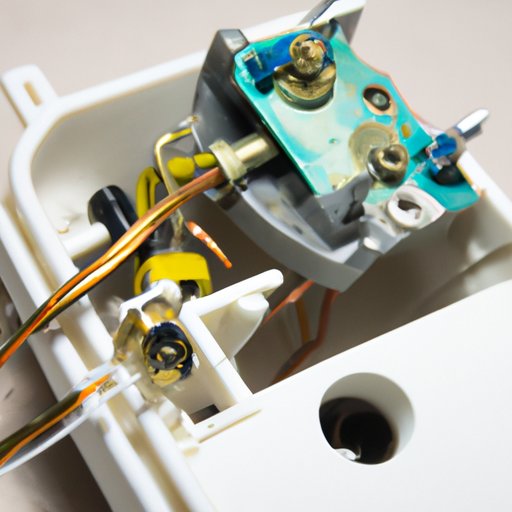
Introduction
Wiring a thermostat is an important task when it comes to controlling your heating and cooling system. Without proper wiring, your thermostat may not function correctly and could even lead to more serious issues. In this article, we will guide you through the process of wiring your thermostat, including common issues and solutions, the benefits of upgrading your thermostat, understanding different types of thermostats, and the importance of properly wiring your thermostat.
Step-by-Step Guide to Wiring a Thermostat
Before you begin, make sure that you have the necessary tools and materials on hand. This includes a screwdriver, wire nuts, wire strippers, and a new thermostat if you are replacing an old one.
Step 1: Turn off power to your heating and cooling system by turning off the circuit breaker or removing the fuse.
Step 2: Remove the existing thermostat cover and detach the wires from the terminals by unscrewing the screws. Remember the colors and the letters labeled on the wires for easy reference.
Step 3: Remove the backplate of your new thermostat and attach the wires to the correct terminals, using the letters and colors labeled on the wires for reference. Use wire nuts to hold the wires in place if necessary.
Step 4: Attach the new backplate to the wall and secure it in place with screws. Replace the thermostat cover.
Step 5: Turn on power to your heating and cooling system and test your new thermostat to make sure it’s working properly.
Common Wiring Issues and Solutions for Thermostats
Even with proper wiring, there are common issues that may arise in your thermostat. These include problems with the thermostat display, wiring compatibility, and power. Here are some solutions to common wiring issues that you may encounter:
Issue: Thermostat display is blank or not responding
Solution: Check the wiring connections and ensure they are securely connected. Make sure that the power is turned on and that the circuit breakers are not tripped. Refer to your thermostat manual for troubleshooting steps.
Issue: Compatibility issues between the thermostat and heating and cooling system
Solution: Make sure that your thermostat is compatible with your heating and cooling system. If you are unsure, consult a professional HVAC technician.
Issue: Power issues with the thermostat
Solution: Check the circuit breaker or fuse for your heating and cooling system and make sure that it is not damaged. If necessary, replace the circuit breaker or fuse.
The Benefits of Upgrading Your Thermostat
Upgrading your thermostat can bring various benefits to homeowners. For one, upgrading can lead to increased energy efficiency and cost savings. A programmable or smart thermostat can help you better manage your heating and cooling system and reduce wasted energy while ensuring your home is still at a comfortable temperature.
To properly wire a new thermostat, you will need to follow the manufacturer’s instructions carefully. Some newer thermostats may require a C-wire that provides constant power to the unit, which may require extra wiring. Make sure to read the instructions carefully before installing.
Understanding the Different Types of Thermostats
There are several types of thermostats available in the market today, each with its own features and functions. These include programmable, smart, and manual thermostats.
A programmable thermostat allows you to set a schedule for your heating and cooling system, so it turns on and off automatically without you having to adjust it manually. A smart thermostat goes a step further and allows you to control your HVAC system remotely using a smartphone app or through voice command. A manual thermostat, on the other hand, requires you to adjust the temperature manually as needed.
Make sure you choose the right thermostat for your needs and follow the manufacturer’s instructions when wiring your thermostat.
The Importance of Properly Wiring Your Thermostat
Proper wiring of your thermostat is crucial to ensuring its longevity and avoiding any potential issues in the future. A poorly wired thermostat can lead to a malfunctioning heating and cooling system, and even cause damage to your HVAC equipment.
Additionally, a correctly wired thermostat can help improve the overall efficiency of your heating and cooling system, reducing energy costs and prolonging the lifespan of your equipment.
Top Mistakes to Avoid When Wiring Your Thermostat
When wiring your thermostat, there are several common mistakes that people make that can lead to problems. These include incorrect wire connections, not following the manufacturer’s instructions, and not turning off power to the heating and cooling system before wiring the thermostat.
To avoid these mistakes, make sure to carefully follow the instructions provided with your thermostat, and consult a professional HVAC technician if you’re unsure about any steps in the process.
Conclusion
Wiring your thermostat is an important step in controlling your heating and cooling system. By following this step-by-step guide and avoiding common wiring issues and mistakes, you can ensure the best performance and longevity of your thermostat and HVAC equipment. Remember to choose the right thermostat for your needs, read the manufacturer’s instructions carefully, and consult a professional if necessary for a safe and seamless installation.




